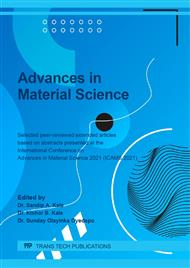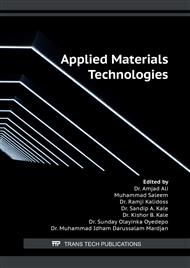[1]
M. T. Sebastian, R. Ubic, H. Jantunen. Low-loss dielectric ceramic materials and their properties. International Materials Reviews, 60 (2015) 392–412.
DOI: 10.1179/1743280415y.0000000007
Google Scholar
[2]
Z. Liu, Y. Wang, W. Wu, Y. Li. Li-Nb-Ti-O microwave dielectric ceramics. Journal of Asian Ceramic Societies. Elsevier B.V.
DOI: 10.1016/j.jascer.2013.02.002
Google Scholar
[3]
S. Takahashi, Y. Imai, A. Kan, Y. Hotta, H. Ogawa. Dielectric and thermal properties of isotactic polypropylene/hexagonal boron nitride composites for high-frequency applications. Journal of Alloys And Compounds, 615 (2014) 141–145.
DOI: 10.1016/j.jallcom.2014.06.138
Google Scholar
[4]
R. Ratheesh. Development and characterization of high dielectric flexible PTFE/ceramic substrates for microwave circuit applications, (2009) 680771.
Google Scholar
[5]
G. Saravanan, K. Ramachandran, J. Gajendiran, E. Padmini. Effect of ceria concentration of Strontium titanate on the structural, optical, dielectric and electrical properties. Chemical Physics Letters, 746 (2020).
DOI: 10.1016/j.cplett.2020.137314
Google Scholar
[6]
X. Guo, Y. Pu, J. Ji, W. Wang, J. Li, R. Shi, M. Yang. Colossal permittivity and high insulation resistivity in Dy- modified SrTiO3 lead-free ceramic materials with low dielectric loss. Ceramics International, 46 (2020) 10075–10082.
DOI: 10.1016/j.ceramint.2019.12.275
Google Scholar
[7]
A. Tkach, T. M. Correia, A. Almeida, J. Agostinho Moreira, M. R. Chaves, O. Okhay, … J. Petzelt. Role of trivalent Sr substituents and Sr vacancies in tetragonal and polar states of SrTiO3. Acta Materialia, 59 (2011) 5388–5397.
DOI: 10.1016/j.actamat.2011.05.011
Google Scholar
[8]
C. C. Wang, C. M. Lei, G. J. Wang, X. H. Sun, T. Li, S. G. Huang, … Y. D. Li. Oxygen-vacancy-related dielectric relaxations in SrTiO3 at high temperatures. Journal of Applied Physics, 113 (2013) 1–10.
DOI: 10.1063/1.4794349
Google Scholar
[9]
R. C. Pullar, S. J. Penn, X. Wang, I. M. Reaney, N. Mcn. Dielectric loss caused by oxygen vacancies in titania ceramics, 29 (2009) 419–424.
DOI: 10.1016/j.jeurceramsoc.2008.06.019
Google Scholar
[10]
G. Subodh, M. T. Sebastian. Microwave dielectric properties of Sr2Ce2Ti5O16 ceramics. Materials Science and Engineering B: Solid-State Materials for Advanced Technology, 136 (2007) 50–56.
DOI: 10.1016/j.mseb.2006.09.015
Google Scholar
[11]
L. Wang, Y. Sakka, Y. Shao, G. A. Botton, T. Kolodiazhnyi. Coexistence of A- and B-site vacancy compensation in La-doped Sr 1-xBaxTiO3. Journal of the American Ceramic Society, 93 (2010) 2903–2908.
DOI: 10.1111/j.1551-2916.2010.03810.x
Google Scholar
[12]
S. Spasović, N. Paunović, D. Popović, J. Dojčilović. Infrared and dielectrical properties of SrTiO3: Nd. Materials Science Forum, 518 (2006) 471–476.
DOI: 10.4028/www.scientific.net/msf.518.471
Google Scholar
[13]
W. Q. Luo, Z. Y. Shen, Y. M. Li, Z. M. Wang, R. H. Liao, X. Y. Gu. Structural characterizations, dielectric properties and impedance spectroscopy analysis of Nd x Sr1-1.5x TiO3 ceramics. Journal of Electroceramics, 31 (2013) 117–123.
DOI: 10.1007/s10832-013-9805-0
Google Scholar
[14]
W. Bian, X. Lu, Y. Li, C. Min, H. Zhu, Z. Fu, Q. Zhang. Influence of Nd doping on microwave dielectric properties of SrTiO3 ceramics. Journal of Materials Science: Materials in Electronics, 29 (2018) 2743–2747.
DOI: 10.1007/s10854-017-8201-y
Google Scholar
[15]
Z. Y. Shen, Y. M. Li, W. Q. Luo, Z. M. Wang, X. Y. Gu, R. H. Liao. Structure and dielectric properties of Nd x Sr1-x TiO3 ceramics for energy storage application. Journal of Materials Science: Materials in Electronics, 24 (2013) 704–710.
DOI: 10.1007/s10854-012-0798-2
Google Scholar
[16]
F. Liu, C. Yuan, X. Liu, G. Chen, C. Zhou, J. Qu. Microstructures and dielectric properties of (1−x)SrTiO3–xCa0.61Nd0.26TiO3 ceramic system at microwave frequencies. Journal of Materials Science: Materials in Electronics, 26 (2015) 128–133.
DOI: 10.1007/s10854-014-2373-5
Google Scholar
[17]
L. Cheng, P. Liu, S. X. Qu, L. Cheng, H. Zhang. Microwave dielectric properties of Mg2TiO4 ceramics synthesized via high energy ball milling method. Journal of Alloys and Compounds. Elsevier Ltd.
DOI: 10.1016/j.jallcom.2014.10.149
Google Scholar
[18]
R. Lowndes, M. Deluca, F. Azough, R. Freer. Probing structural changes in Ca (1-x) Nd2x/3TiO 3 ceramics by Raman spectroscopy. Journal of Applied Physics, 113 (2013) 1–7.
DOI: 10.1063/1.4789601
Google Scholar
[19]
S. Jin, X. Qiu, B. Huang, L. Wang, Q. Zhang, Z. Fu. Dielectric properties of modified BNT/PTFE composites for microwave RF antenna applications. Journal Of Materials Science-Materials In Electronics, 27 (2016) 8378–8383.
DOI: 10.1007/s10854-016-4849-y
Google Scholar
[20]
S. Jin, L. Wang, Z. Wang, B. Huang, Q. Zhang, Z. Fu. Dielectric properties of modified SrTiO3/PTFE composites for microwave RF antenna applications. Journal of Materials Science: Materials in Electronics, 26 (2015) 7431–7437.
DOI: 10.1007/s10854-015-3374-8
Google Scholar
[21]
S. Rajesh, K. P. Murali, R. Ratheesh. Temperature stable low loss PTFE/rutile composites using secondary polymer. Applied Physics A-Materials Science & Processing, 104 (2011) 159–164.
DOI: 10.1007/s00339-010-6088-z
Google Scholar
[22]
A. Ashokbabu, P. Thomas. Dielectric and Thermal Behavior of Polystyrene/Sr2TiMnO6 (STMO) Composites. Transactions of the Indian Ceramic Society, 80 (2021) 96–102.
DOI: 10.1080/0371750x.2021.1888806
Google Scholar



